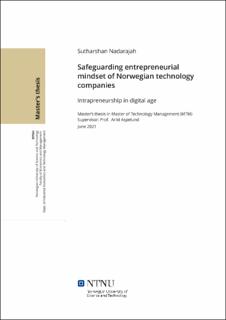| dc.description.abstract | The main purpose of this thesis is to examine how established Norwegian technology companies can
safeguard the entrepreneurial mindset. The average lifespan of companies has reduced dramatically
over the last 50 years, which can be attributed to the disappearance of the entrepreneurial mindset
over time and the companies’ inability to maintain and develop the entrepreneurial mindset in
parallel with the operational efficiency mindset.
Having worked for a Norwegian technology company for several years, I have experienced how
difficult it is to bring changes to established structures to explore new business areas. Therefore,
there is a real need to study how established Norwegian technology companies can maintain an
entrepreneurial mindset and survive in highly competitive markets.
To achieve this thesis’s purpose and to optimally utilize the theoretical frameworks, the following
question is posed: Based on the theoretical frameworks of ambidextrous organization, how can
entrepreneurial mindsets be safeguarded in established Norwegian technology companies?
To answer this question, Norwegian technology companies that may have experienced disruption
(according to the theoretical framework of disruptive innovation) in their respective industries were
selected.
The framework of ambidextrous organization comprises two distinctive types of business units
within a company. One unit focuses on leveraging existing business (i.e., exploiting), and the other
unit focuses on exploring new opportunities for future growth. The framework also defines two
different company-level factors required to succeed with these two different business units.
Company-level factors defined for the exploratory business unit are related to the general definition
of the entrepreneurial mindset. Based on this relationship, this thesis claims that safeguarding the
entrepreneurial mindset of established Norwegian technology companies requires a focus on the
company-level factors needed for the exploratory business defined by the framework of
ambidextrous organization.
Empirical findings in this thesis show that the entrepreneurial mindset, which is naturally part of the
establishment period of the company, tends to disappear during the growth period of the company.
Empirical findings in thesis also show that it is hard to suddenly build an entrepreneurial mindset in
the mature period without continually practicing the entrepreneurial mindset in the growth period.
Empirical findings also show that an ambidextrous organization is specifically relevant if the
established Norwegian technology company can benefit from the company’s existing assets and
operational capabilities.
Finally, the thesis concludes that if an established Norwegian technology company can benefit from
the company’s existing assets and operational capabilities, the entrepreneurial mindset can be
safeguarded by establishing a separate exploratory business unit within the company that focuses
on the company-level factors of an exploratory business unit defined by the framework of
ambidextrous organization. This thesis also concludes that it is hard to suddenly build an
entrepreneurial mindset in a company without continually practicing it during the growth period of
the company. The thesis recommends how to build an exploratory business unit within an
established Norwegian technology company to safeguard the entrepreneurial mindset. It concludes
that the ambidextrous organization helps to preserve counterattacks and be resilient against
unexpected disruptions from new entrants according to the theoretical framework of disruptive
innovation. | |
